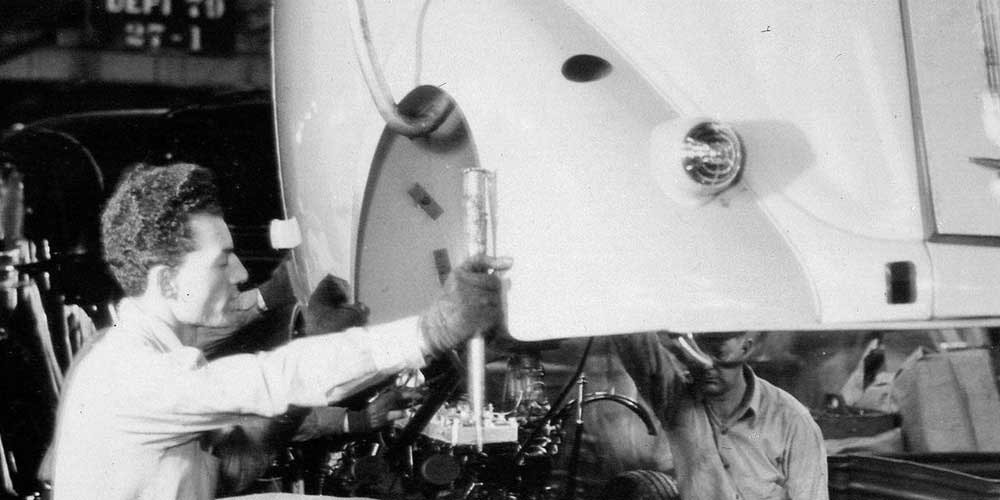by A. Wayne Ferens
Photos from the Ferens Collection, Dave Friedman Collection, Robert Walker Collection, and Lynn Park Collection
Published 12.27.2023
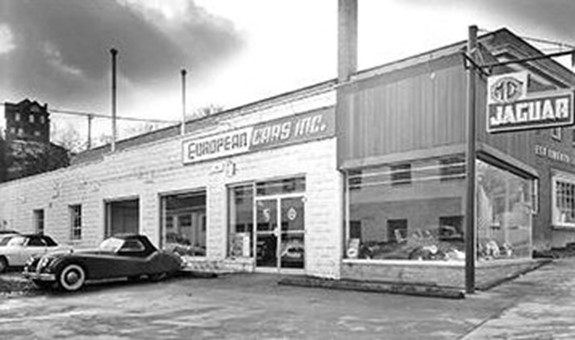 European Cars, Inc., established in 1952 in Pittsburgh PA (Ferens Collection)
European Cars, Inc., established in 1952 in Pittsburgh PA (Ferens Collection)
James Edward Hugas was a member of the "Greatest Generation" that won World War II. He was born on a Pennsylvania farm on June 30, 1923. When the war broke out, Hugas joined the army and completed basic training at Fort Benning, Georgia – then, he became a paratrooper with the 11th Airborne Division and served in the Pacific Theatre. He mustered out in 1946 and returned to Pennsylvania where he discovered European sports cars and saved enough money to purchase a MGTC.
In 1952, Hugas and a partner named Parker Davis opened an MG dealership in Pittsburgh and within a year added Jaguar to their lineup. The dealership was called European Cars, Inc. and was located at 2535 West Liberty Ave. in the South area of Pittsburgh. Over the next several years, Hugas would own three different car dealerships that would sell and service a variety of imports. He also became the U.S. Distributor of Isis Formula Juniors that were made by Alejandro De Tomaso.
Hugas was a well-respected businessman and road racer. He joined the SCCA in 1951 and ran his first race at McDill Air Force Base in a Jaguar XK120. Over the next decade and a half, Hugas drove everything from MG, Alfa Romeo, Cooper, Porsche, Ferrari and BMW. He was extremely competitive in the 1950s and 1960s driving in the Sebring 12 hour many times where he won the GT class and came in 4th overall in 1960 with co-driver Augie Pabst in a Ferrari 250 GT. He competed in the Le Mans 24-hour race for ten consecutive years starting in 1956, and finally came in first overall in 1965 with co-drivers Masten Gregory and Jochen Rindt in a Ferrari 275 LM entered by NART, the North American Racing Team. Hugas had a great sense of humor and became friends with many of the drivers including the 1959 Le Mans-winning driver, automotive designer and entrepreneur Carroll Shelby -- and this is where the Hugas-Shelby Cobra connection begins.
In the early 1960s, Shelby came up with the idea of building a light-weight, high performance sports car using the British built A.C. Ace cars rolling chassis, and installing a Ford Fairlane 260 cu. in. small block V8 engine with a hefty Ford Borg-Warner four-speed transmission. Shelby had the idea, but he didn't have the money or a facility to begin the project on a large scale, so he contacted Ed Hugas in Pittsburgh for help. Shelby completed the first prototype car, serial no. CSX 2000, in California, and the performance of the car was impressive to say the least.
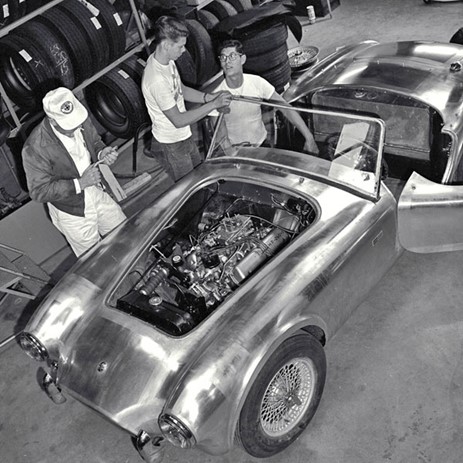 The first aluminum bodied A.C. Cobra prototype CSX2000 being completed at Shelby's tire shop in California February, 1962. (Dave Friedman Collection)
The first aluminum bodied A.C. Cobra prototype CSX2000 being completed at Shelby's tire shop in California February, 1962. (Dave Friedman Collection)
Hugas put up the funds and ordered the first seven modified but unfinished Aces from the A.C. Cars factory in England. A few months later when the cars arrived, Hugas had his mechanics in the service department at European Cars in Pittsburgh install the Ford 260 V8 and four-speed transmission in the A.C. chassis, and completed the cars for sale. Shelby acquired a fairly large facility in Venice, California and almost immediately Ford signed a contract for Shelby American Cobra production.
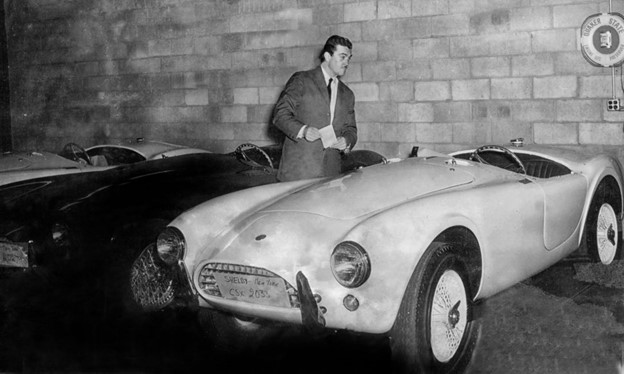 Hugas with an early Cobra at his European Cars dealership. (Ferens Collection)
Hugas with an early Cobra at his European Cars dealership. (Ferens Collection)
Hugas is documented as having raced the first production Cobra (CSX2001) at Connellsville, Pennsylvania on August 26, 1962. Several months later, a Shelby American Cobra had its debut with Bill Krause driving CSX2002 at Riverside. Hugas was also the first American driver to pilot a Cobra at Le Mans in 1963 with his own car, CSX2142. Hugas was the first to bring the initial Cobra sports car to production and gets the credit for completing the first seven cars. Many cars were completed in his shop and sold by him in those early years. Hugas also became the first authorized Cobra dealer and East Coast Cobra Distributor.
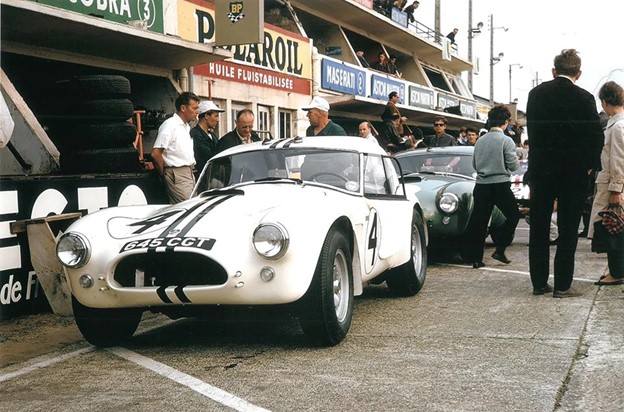 Hugas own car, CSX2142, during the first days of practice at the 1963 Le Mans 24 hour race. The first Cobra to appear at La Sarthe. (Robert Walker Collection)
Hugas own car, CSX2142, during the first days of practice at the 1963 Le Mans 24 hour race. The first Cobra to appear at La Sarthe. (Robert Walker Collection)
In 1968, Hugas sold all of his Pittsburgh businesses and moved to Jacksonville, Florida, where he took on the Southeast distributorship for BMW. His last race was in a BMW 2002 at Sebring in 1969. In 1974, he sold the distributorship back to BMW and retired. Hugas and Shelby remained close friends through the years until Hugas died on June 29, 2006. He was truly one of the greats and was ranked with some of the best professional drivers of the era. He was a founding father of the Steel Cities Region of the Sports Car Club of America. Without J. Edward Hugas, the Cobra may never have reached fruition, becoming one of the most iconic high-performance sports cars in history.
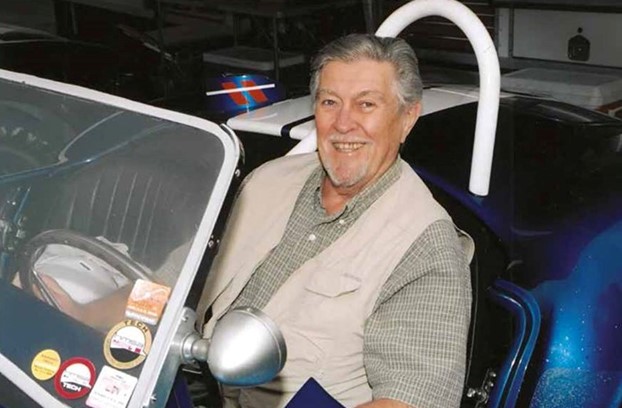 Ed Hugas at Leguna Seca in 2005 (Lynn Park Collection)
Ed Hugas at Leguna Seca in 2005 (Lynn Park Collection)
Original Cobra production from 1962 - 1967:
MKI - production 1962 - 1963, 260 or 289 Ford V8
MKII - 1963 - 1965 289 Ford V8
MKIII - 1965 - 1967 289 - 427 or (428)
Shelby Cobras were produced in low quantities with just 998 assembled, (655 leaf-spring small block V8 Cobras and 343 coil-spring big block V8 Cobras). These numbers include street cars, competition cars and semi-competition roadsters.
Bibliography
Friedman, Dave. “Shelby Cobra.” 1994.
Shelby, Carroll. “The Cobra Story.” 1965.
Laban, Brian. “Shelby and the A.C. Cobra.” 2015.
Walker, Robert D. “Cobra Pilote.” 2017.
Ed Hugas Obituary, 2006


